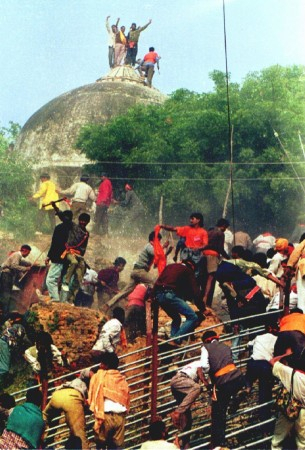
November 9 could go down in the history of India as one of the most important days. A five-member bench of the Supreme Court, headed by none other than the Chief Justice of India, Ranjan Gogoi, would deliver its judgement on the Ayodhya Ram Janmabhoomi-Babri Mosque dispute.
This case has no parallel in not just Indian but legal history of the world. No case has had such political and social repercussions as this one. It has been in the system for a very long time. With so much sentimental value attached to the outcome of the matter, many steps are being taken to ensure that law and order doesn't get affected.
However, many people, especially millenials, are not aware of the entire history of this case. Some facts, like the demolition of the disputed structure, are well-known but what happened before and after isn't something many people are fully aware of. So, here is a timeline of this entire issue, right from its genesis to the current scenario.
1526: Babur becomes hegemon in India
The first battle of Panipat in 1526 saw Zahir-ud-din Muhammad Babur, a Moghul descendant of Tamerlane and Genghis Khan, defeat Ibrahim Lodhi in the first battle of Panipat to assume the status of India's emperor.
The construction of Babri Masjid – the building that was at the center of the entire dispute – began in 1528 under the supervision of Mir Baqi, a top general in Babur's army. Of course, the dispute is over what existed on the spot prior to the building of the mosque. Some believe it was a grand temple while some say it was just an ordinary location.
1856: Britishers gain control of Ayodhya region
As the British power increased across India in the 19th century, one-by-one, all states of the country started to come under British control, directly or indirectly. The Ayodhya region was taken over by the Britishers in 1856. This meant that the law and order of Ayodhya and legal matters in the region would now be handled by British Indian authorities.

1858: First report related to the disputed site officially filed
In November 1858, the thanedar of Awadh files a complaint – the first legal record of the case – in which he says that a group of nihang Sikhs has gone into the mosque and has written the word 'Ram' on the walls as well as organised a havan inside the building.
1885: Case filed in Allahabad High Court
The late 19th century saw an avalanche of court cases filed in the courts relating to the possession of the disputed land. In 1885, the main case was filed in the Allahabad High Court by the mahanth of 'Janam Sthan' Raghubar Das. The Suit No. 61/280 sought permission to construct a temple over the 'Ram Chabutara.' Soon, the Mutawalli of the Babri Mosque filed an impleadment application in the same suit. The Ayodhya case had begun.
On December 23, 1949, at 7 PM, the sub-inspector of Ayodhya Thana, Pandit Sri Ram Deo Dubey lodged a FIR stating that at 7 AM in the morning, a crowd of Hindu devotees broke the locks of the Babri Masjid compound and forced their way into the mosque structure. They proceeded to place a small idol of Ram lalla – the infant Lord Ram – in the building.
1986: Locks of Babri Masjid-Ram Temple disputed structure opened
The year 1986 was a crucial one in the history of this dispute. The district judge had ordered that the locks, which had been put on the place since the incident of 1946, be opened. The central government at the time – Rajiv Gandhi's Congress government – allowed the locks to be opened and puja to be performed. This was seen as a measure to counteract the impact of the same government's decision to overturn the Shah Bano judgement and not appear too appeasing towards the Muslims.
1989: BJP's Palampur resolution
In 1989, the Bharatiya Janata Party, in its annual convention held at Palampur in Himachal Pradesh, adopted a resolution in which it committed itself to the construction of the Ram Temple at the disputed site. This was followed by Lal Krishna Advani's rath yatra next year from Somnath to Ayodhya and the arrival of the dispute in its full-fledged form at the political level.
Construction material meant for building the proposed Ram temple in Ayodhya. (File Photo: IANS)
Construction material meant for building the proposed Ram temple in Ayodhya. (File Photo)IANS
1992: Disputed site demolished
On December 6, 1992, kar sevaks of various organisations like Vishwa Hindu Parishad (VHP), Rashtriya Swayamsevak Sangathana (RSS) and BJP gathered at Ayodhya. Around mid-day, members from the crowd mounted the central dome of the structure and started dismantling it. Soon, the entire crowd joined in and the structure was demolished and the lalla statue installed in a makeshift structure. This was followed by riots throughout India.

2010: Allahabad High Court judgement
On September 30, 2010, the Allahabad High Court delivered its judgement on the Ram Mandir-Babri Masjid case. The three-judge bench ruled that there indeed was a major temple at the site of the mosque though one of the judges said that the temple was already in a state of ruin. The bench gave a unique ruling where it decided to divide the land into three parts between the Ram Janambhoomi Nyas, Nirmohi Akhara and Sunni Wakf Board.
The High Court judgement was challenged in the Supreme Court by multiple parties and after various twists and turns, the judgement by the highest court of India would be delivered on October 9.








